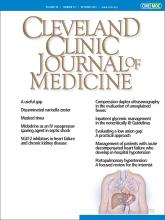Article Figures & Data
Tables
Authors Study design Patient population Outcomes Lal et al9 Pilot, placebo-controlled, double-blind, randomized trial Adult medical ICU patients hospitalized with sepsis; mean arterial pressure < 70 mm Hg despite sepsis treatment Decreased duration of IVPs (P = .19)
Decreased total IVP requirement (P = .59)
Shorter ICU length of stay (P = .36)
Similar hospital length of stay (P = .41)Whitson et al7 Single-center retrospective cohort study Patients hospitalized with septic shock requiring at least 24 hours of IVPs who demonstrated a period of clinical stability Decreased IVP duration (P < .001)
Decreased ICU length of stay (P = .017)
Reduction in total IVP days and ICU patient days over year of studyAdly et al10 Single-center retrospective control study Resuscitated patients with septic shock who demonstrated clinical stability on low-dose IVP for at least 24 hours Reduced IVP (norepinephrine) duration (P = .001)
Shorter IVP weaning period in septic shock recovery phase (P < .001)
Decreased mortality (43.3% vs 73.3%, P = .018)Santer et al11 Randomized, double-blind, placebo-controlled trial Hypotensive adult patients on single-agent IVP unable to be weaned from IVPs for at least 24 hours No difference in time to IVP discontinuation (23.5 vs 22.5, P = .62)
No difference in ICU length of stay (6 days vs 6 days, P = .46)
No difference in time to ICU discharge readiness (5 days vs 5 days, P = .64)
No difference in ICU readmission rate (1.5% vs 4.5%, P = .62)
Increased rates of bradycardia (7.6% vs 0%)ICU = intensive care unit; IVP = intravenous vasopressor






